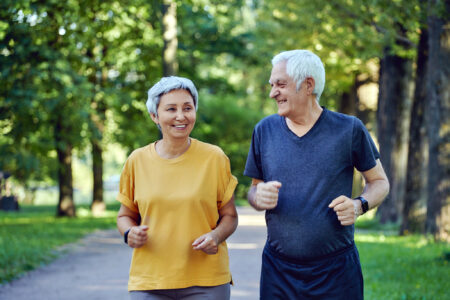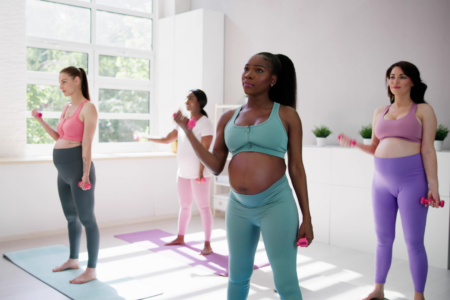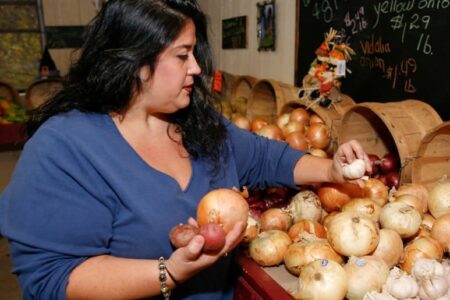Share On Social!
Growing up, Dante Jones always looked forward to weekend bike rides with his father.
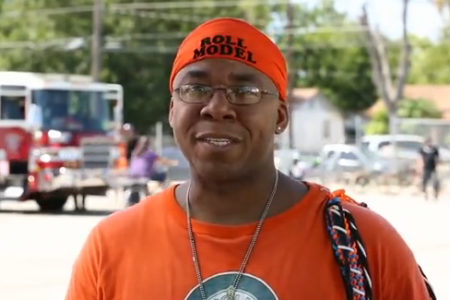
In those rides with his dad, Jones said he learned important life lessons and experienced the beauty of the outdoors, all while getting exercise.
So when his daughter, Glory, was old enough to ride a bike he decided to start a similar tradition. He hoped it would allow them to spend more quality time together and instill in her the value of living an active lifestyle and the fun of activities like biking and skating.
Jones noticed that other children from the neighborhood wanted to tag along when he and his daughter would go out for bike rides. He invited them along.
He started to realize that there was a lack of positive role models in the neighborhood, and also a lack of afterschool programs to keep kids physically active and safe off the streets.
So he sprang into action.
Learning about the need for mentors, activity

Through his wife, Dante learned about the non-profit group Urban Connection San Antonio.
The group is a community development ministry that works to address neighborhood issues related to poverty, like hunger, health, housing, and education.
Jones started volunteering with Urban Connection, which operates out of a community center near Lincoln Heights Courts, a San Antonio Housing Authority (SAHA) public housing property.
Jones learned of the need to mentor young kids.
He soon invited some of the youths at Urban Connection to roller skate in his neighborhood.
“[It was] to teach them it was okay to fall and get back up, and not to laugh when somebody fell, because they could very well be in that situation,” Jones said. “After just a few hours of being there they built that camaraderie, that cohesiveness.”
In 2010, Jones started up an informal group he called Roll Models to incorporate skating and biking with lessons on overcoming life’s challenges.
“A Roll Model is someone that possesses or desires to possess values like responsibility, integrity, courage, humility, enthusiasm, and service—RICHES,” Jones said.
He continued to give neighborhood kids more opportunity for learning and exercise, but there still was no formal time or resources set aside for a community-wide ride.
Beth Keel, a sustainability initiatives specialist with the SAHA Risk and Sustainability Department, was aware of the growing obesity rates in San Antonio, where more than 60% of the population is Latino. She also noticed that obesity was higher in low-income families.
Physical activity is a key to preventing obesity, several studies show.
So Keel, having lived more than a decade in Colorado, where “biking was the norm,” was particularly alarmed when she noticed San Antonio’s lack of ability to ride bikes safely.
“It was a huge culture shock, not being able to ride my bike safely,” Keel said. “Not being able to ride to work was difficult.”
Keel became head of SAHA’s new Health and Wellness committee at SAHA. She had already worked with the community to establish a farmer’s market and community gardens at some of SAHA’s public housing locations.
In 2012, Keel and SAHA gave away 1,000 bikes to SAHA residents as part of a Center for Disease Control and Prevention (CDC) Community Putting Prevention to Work (CPPW) grant.
“I still see residents riding their bikes,” Keel said.
Keel thought it would be great to activate these individuals to use the bikes they had been given and help them to lead healthy lifestyles, by starting a monthly bike ride.
Dante connects to city leaders to plan a regular bike ride
In late 2012, SAHA hosted a wellness fair and invited community members to learn more about the wellness committee’s activities.
Partner organizations who were interested were invited to attend a meeting.
Keel discussed the mission of the health and wellness committee at these meetings and also promoted the idea of organizing monthly bike rides for residents living in public housing.
Leslie Kelsie-Grubbs, executive director of Urban Connection, attended one of these meetings.
Kelsie-Grubbs suggested Keel speak with Jones, who she knew was passionate about seeing more kids participate in safe physical activity.
Keel contacted Jones.
“It was just like seeing myself,” she said. “We just saw eye to eye on everything.”
Jones explained to Keel that he worked with a group of about 15 kids ages 8-18 from Urban Connections through the Roll Models program in his neighborhood.
He was interested in giving the kids an opportunity to see things outside their neighborhood and a chance to participate in monthly bike rides.
Keel and Jones brainstormed who might also lend their support.
Jones immediately thought of asking for support from Eric Cerda of Popo’s We-Cycle, who he had met at an art mural tour. A few months prior, Cerda had started Popo’s We-Cycle, a group that takes unwanted bikes, repairs them and donates them to individuals who can’t afford a bike. Popo’s We-Cycle also has a program for kids ages 12 and older interested in learning to repair bikes. Through this program, kids can earn their own bike, once they complete 40 hours of volunteer work.
After teaming up with Jones, Keel organized an April 2013 meeting of groups interested in a monthly bike ride.
She invited representatives from the Bexar County Metropolitan Planning Organization (MPO), the Texas A&M AgriLife Extension Campus, the San Antonio Police Department (SAPD), San Antonio Metropolitan Health District (Metro Health), the San Antonio Mayor’s Fitness Council, and others.
Cerda was also invited by Keel, Jones and Judit Vega of Metro Health. Vega had learned about Cerda’s We-Cycle program from Catarina Velasquez, a program director for Guadalupe Street Coffee—a community development project with after-school programs for local kids. Months prior, Velasquez had put Vega in contact with Cerda, after learning that Cerda had replaced a stolen bike for a boy who attends Guadalupe Street Coffee activities.
“Judit and Dante told me, ‘You need to be here. You need to come and get involved in this,’” Cerda said. “So I did.”
At the meeting in April 2013, supporters discussed plans for more biking in the area.
The idea for a monthly bike ride got a lukewarm reception, at first.
“Some folks didn’t think it would work, so we had to convince them: ‘Well, let us try it,’” Keel said. “It took a bit of discussion, but we got everyone on board.”
Once the idea gained traction, talk centered on location, timing, and other plans.
The group talked about starting the ride from different SAHA public housing locations each month.
Some meeting participants suggested the need for security and oversight of security. Police officials agreed to provide a security detail, at least at first.
Others recommended having children’s activities and healthy snacks after each bike ride.
In the end, the group decided to pursue monthly rides, starting in May 2013.
The first ride would follow a 3-mile stretch from Alazan-Apache Courts, a public housing development, to Woodlawn Lake.
“We chose that location for two reasons. One, Alazan-Apache is our oldest public housing in San Antonio and one of the oldest in the country,” Keel said. “And two, the zip code that Alazan-Apache is in had the largest amount of pedestrians and cyclists that have gotten injured and killed.”
Starting a monthly ‘Roll Model’ bike ride for kids
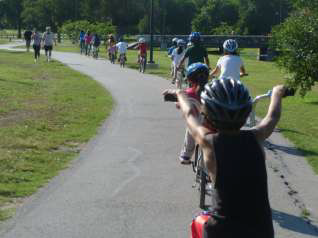 Keel, Jones, Cerda, and others immediately began spreading word of the new monthly bike rides through postings on their personal Facebook accounts.
Keel, Jones, Cerda, and others immediately began spreading word of the new monthly bike rides through postings on their personal Facebook accounts.
Keel created a flyer for committee members and SAHA employees to hand out and post at all public housing locations. She also handed out flyers at the SAHA farmers’ market and at other SAHA events.
“It’s a lot of word of mouth—just telling people about it,” Keel said.
Jones and Cerda got the word out to the bicycle community.
“The bicycle community here is amazing,” Jones said. “They will welcome you in no matter what type of bike you have or where you come from.”
Supporters created a list of eight goals and objectives for the monthly bike rides:
- Create a fun safe learning environment to inspire the citizens of San Antonio
- Reduce pedestrian and bicycle-related accidents in San Antonio
- Reduce the San Antonio obesity epidemic
- Increase safety and awareness among cyclists and vehicle drivers
- Transform San Antonio into a bicycle-friendly commuters city
- Educate SAHA residents on the importance of nutrition and physical activity
- Increase family participation
- Create a positive movement in San Antonio
They also scheduled monthly meetings for the first Wednesday of every month, to discuss how they would institute the bike rides.
In the days leading up to each meeting, they agreed to use email to try to finalize general planning for each ride, thus leaving room at the meetings to finalize finer details and future rides.
“Our mission is to get more people on bicycles,” Cerda said. “And we want to make biking cool again.”
The group conducted its first monthly bike ride on Saturday, May 11, 2013.
About 55 people showed up to the first bike ride, a three-mile trek.
The growth of the monthly rides
“On the first ride we had about 55 participants, by the second ride we had about 95, and by the third ride we had almost 150 participants,” Keel said.
Police escorts followed the group for the first and second bike ride; Cerda and his team agreed to take care of security for events after that.
For the first ride, the Bexar County Texas A&M AgriLife Extension Campus donated healthy snacks and SAHA purchased oranges, bananas, and water for the kids.
“Everyone worked with each other,” Jose Rios, a risk and sustainability specialist with SAHA, and volunteer with the bike ride said. “It seemed like they had been doing it for years.”
Those wearing SAHA T-shirts and street team T-shirts kept everyone in a line.
Dante’s Roll Models wore their bright-orange T-shirts as they led the group.
“We chose orange because it’s not a gang color, so it seemed pretty safe, and it also made us very visible, and it’s a great color that inspires creativity,” Jones said.
Jones also made the ride enjoyable for the group by playing tunes from his iPod which is heard through a speaker that sits on a trailer attached to his bike.
The third bike ride in July 2013 was a huge success. Riders had a chance to ride from downtown to Mission José.
Allie Blazosky of the Bexar County MPO also came out to teach the riders hand signals and safety rules for cyclists.
For the fourth bike ride in August 2013, the group was able to get free passes into the Witte Museum for participants. In the future the group would like to give riders the opportunity to experience kayaking and maybe even a camping trip.
Supporters continue to look for partners and opportunities so that the monthly bike ride can continue for a long time to come and inspire safe physical activity for kids after school.
“It keeps growing, we had about 30 people show up at one partners meeting,” Keel said. “Now we don’t necessarily have to meet every month, because we’re so used to doing it, but we still meet to see if there’s anything we can do better.”
As for the Roll Models group, they’re hoping to get more participants, too.
“We are looking to expand throughout the San Antonio Housing Authority properties,” Jones said.
The group is working with Metro Health and SAHA to see how they can accomplish this.
“We would like to train teenagers to become Roll Models in their own neighborhood,” Jones said. “Because there’s nothing like having a physical role model who grew up and came out of what you came out of, to be able to set the example for you.”
Explore More:
Green & Active SpacesBy The Numbers
33
percent
of Latinos live within walking distance (<1 mile) of a park
This success story was produced by Salud America! with support from the Robert Wood Johnson Foundation.
The stories are intended for educational and informative purposes. References to specific policymakers, individuals, schools, policies, or companies have been included solely to advance these purposes and do not constitute an endorsement, sponsorship, or recommendation. Stories are based on and told by real community members and are the opinions and views of the individuals whose stories are told. Organization and activities described were not supported by Salud America! or the Robert Wood Johnson Foundation and do not necessarily represent the views of Salud America! or the Robert Wood Johnson Foundation.

